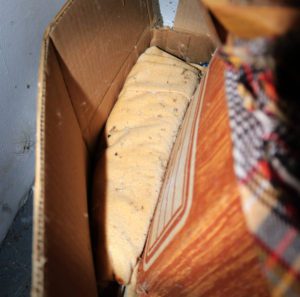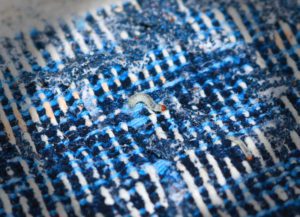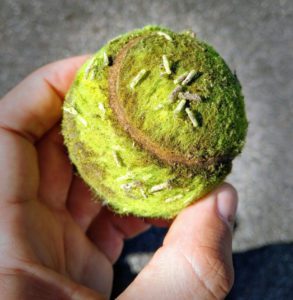FINDING INSECT DAMAGE TO YOUR SWEATERS AND WOOLENS?
By Chris Williams on October 9, 2019.
If so, it can almost certainly be traced back to the way your sweaters, suits, and blankets were stored away early in the summer…
WHAT KIND OF SWEATER STORER ARE YOU?
There seem to be two major strategies when it comes to storing unused winter clothes over the summer months:
(1) DO YOU STORE THEM IN PLACE? – Those lucky enough to have the space may just leave those too-warm clothes where they are until fall, either hanging in the closet or folded in a drawer or on a shelf. Maybe the only concession is that the winter clothes are pushed to one end of the closet rod, into a dark corner and out of the way for a few months. Not necessarily a good idea. See below to find out why.

Cardboard box holding clothes and wool blankets is infested with clothing moths. Z. Ciras.
(2) DO YOU BOX THEM UP? – Other folks do as their mothers and grandmothers did. In the olden days, they not only swapped out clothes seasonally, they even changed bed linens and furniture covers to reflect the temperature changes. The vast majority of people with limited storage space simply go through their closet or drawers, fold up sweaters and other woolen items no longer needed and pack them into cardboard boxes or zippered garment bags. Bad idea. Maybe they throw in a few moth balls for good measure. Usually a waste of money. Maybe they put the boxes in the attic. Another bad idea. Or maybe they feel reassured when they pack their clothes in a cedar chest instead. Clothes may smell nice but they are not protected. How should you pack away woolens? See below to find out.
FABRIC PEST BASICS

Clothing moth larvae actively feeding on a wool carpet. Z. Ciras
There are a few groups of insect pests that feed on woolens and some other fabric blends (see What Chewed Holes in My Wool Blanket?). The two most important are the clothes moths and the carpet beetles. Yes, carpets used to be mostly woolen, but these beetles have branched out (see What Are the Signs of Carpet Beetles?). For both groups, it’s the larval stage that does the feeding damage, resulting in holes in the fabric and often yellowish fecal stains as well.
There are certain conditions that particularly attract these moths and beetles. The more of them that exist, the more likely those woolens will be infested. They look for woolens in dark places where they can feed undisturbed. And then, they feed in the most hidden areas of the garment, underneath collars, lapels, cuffs, or button plackets. Be sure to check these back sides on clothes if you are looking for the insects, their cocoons, or their damage. Fabric pests also prefer woolens that are soiled with food stains, perspiration, urine, or other bodily fluids. The soiled spots provide additional nutrition, clean woolens are not nearly as attractive. See Why Do Fabric Pests Prefer to Dine on Dirty Clothes?
STORAGE STEPS FOR METHODS (1) OR (2)
(1) The most important thing you can do if you are going to store woolen sweaters, other garments, or blankets in place for the summer is have them professionally cleaned first. Admit it, you will probably have them cleaned when you start to wear or use them again in the fall anyway. Doing it before storage can be a big factor in whether you have infestations and will even save you a step later. Then, resist the urge to shove these unused woolens into dark corners of closets or dressers. Let them breathe.
(2) None of the steps listed in method (1) above will do anything to prevent fabric pest infestations. Here’s how you should store woolens:
- Again, the woolens should be professionally cleaned before you pack them away.
- Items should be packed into impermeable containers that insects cannot squeeze into or chew into. There’s nothing about a cardboard box that will keep insects out. In fact, the corrugations provide nice hiding places. Use plastic tubs with tight-fitting lids or zip-lock bags.
- Moth balls, moth crystals, etc. are almost never used correctly and in fact, because they are toxic fumigants, can be dangerous the way some people use them. They only work a little when used in large quantities in airtight containers. See Do Mothballs Repel Clothes Moths, or Not?
- Cedar closets, cedar chests, cedar balls likewise do not give off enough vapors to affect fabric pests in the manner in which they are used.
- Storing your boxed-up clothes in an attic is an invitation for infestation, especially if they are in cardboard boxes. Attics are dark, undisturbed, and already home to many types of pests including silverfish that love dark cardboard boxes and are also secondary fabric pests.

Case-making clothing moths feeding on used dog ball. Z. Ciras
You Might Need Help With Clothes Moth Infestation – If despite your best efforts, it seems that fabric pests have run amok in your attic or closets, you might need professional help (with the pests, that is!) Both clothes moths and carpet beetles can infest other items in your home such as furs, hides, trophy mounts, feathers, and wool or wool blend rugs. Call Colonial Pest for a fabric pest inspection and treatment.